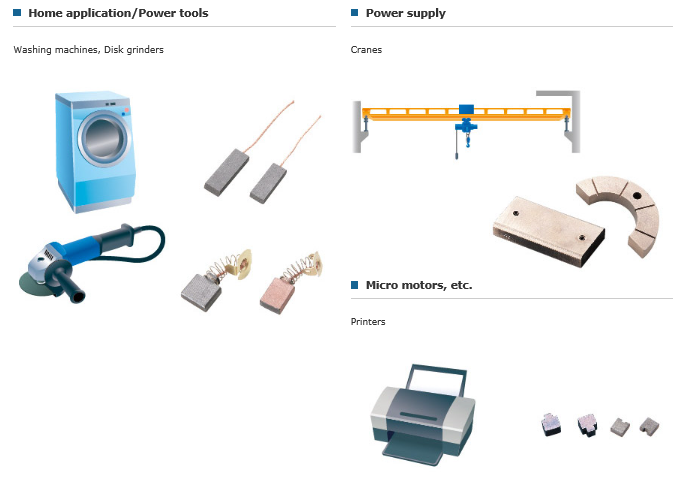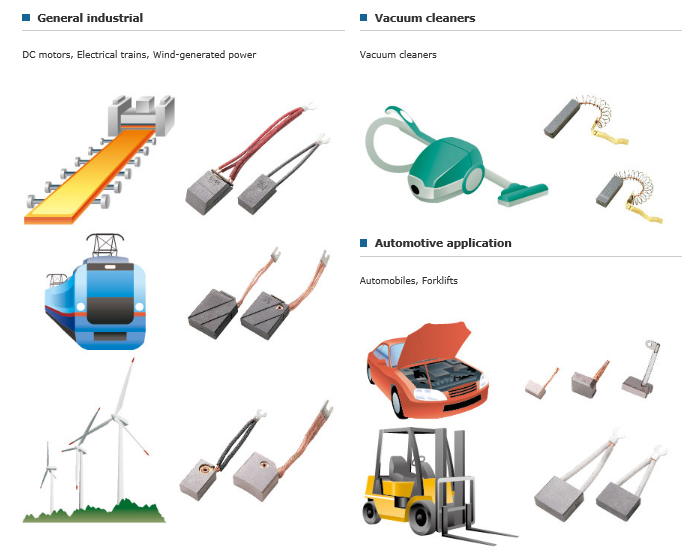
Grades of Carbon Brushes
- Resin Bonded
- Metal Graphite and Silver Graphite
- Carbon graphite
- Natural Graphite
- Electrographite
Resin Bonded
Powdered natural or artificial graphite is mixed with a thermo-setting resin.The mix is then pressed and polymerized at a suitable temperature.
Main Characteristics
Carbon brushes with high to very high electrical resistance, contact drop, electrical loss,and mechanical strength, which have very good commutating and cleaning properties.They can also work at very low current densities.
Main Applications
- AC Schrage-type commutator motors
- Medium-speed DC machines at medium voltage
Operating Limitations
- Resin-bonded grades should not be used at higher than rated current
- Brush current density: 10A/cm2 continuous
- Admissible peripheral speed: 40 m/s (131 ft/s)
Metal Graphite and Silver Graphite
Powdered natural or artificial graphite is mixed with a thermo-setting resin, copperpowder, and/or other metal powders. The mix is then pressed and polymerizedat a suitable temperature in an inert atmosphere.
Main Characteristics
Dense to very dense carbon brushes with low friction and very low contact drop, therefore operating with very low losses and high currents.
Copper-based brush grades
Main Applications
- Low-speed, low voltage DC machines
- Medium-speed, highly-loaded AC asynchronous machines (wind turbine generators)
- Medium-speed AC synchronous motors slip rings
- High current collection systems (electrolytic treatment lines, wire annealers, galvanizinglines ...)
- Low-voltage current collection (military, medical, paramedical, signal ... )
- Special machines
- Slip ring assemblies in rotary joints
Operating Limitations
- Current density:
- 10 to 30 A / cm 2 (75 to 200 A/in 2 ) under steady conditions
- Up to 100 A / cm 2 (660 A/in 2 ) for peak loads, depending on metal content
- Peripheral speed: up to 35 m/s (115 ft/s), depending on metal content
Silver-based brush grades
Silver grades have a higher conductivity than copper grades and form a special low resistance film due to the conductivity of silver oxide. Silver grades can also transfer low voltage current signals without degradation.
Main Applications
- Signal current transmission (thermocouples, thermometric sensors, regulation...)
- Pulse transmission to rotating devices (radar, prospection..)
- Tachometer generators
- Aerospace and space applications
- Shaft grounding in a dual-grade construction
Operating Limitations
- Current density up to 50 A/cm 2 (440 A/in 2 ).
- Peripheral speed: up to 25 m/s (82 ft/s)
Carbon graphite
They are made from a mixture of coke and graphite powders, agglomerated with pitch or resin. This powder is molded into blocks which are baked at high temperature to convert the binder into coke. These materials are not graphitized.
Main Characteristics
Carbographitic brushes commutate well due to their high resistance and provide good polishing action, while maintaining moderate contact drop. As a result of their high temperature treatment, carbographitic brushes can withstand both high temperatures and variable loads.
Main Applications
- Machines with an older design, mostly characterized by a slow speed, lack of interpoles,generally operating at low voltage
- Modern small machines, operating with permanent magnets, servomotors, and universalmotors
- Low voltage battery powered motors
Operating Limitations
- Current density in the brushes: 8 to 16A /cm 2 (50 to 100 A/in 2) depending on the application
- Maximum peripheral speed: 25 m/s (82 ft/s)
Natural Graphite
The main ingredients are purified natural graphite and artificial graphite, mixed with additives, agglomerated with appropriate binders, and treated at a high temperature to carbonize the binder.
Main Characteristics
LFC brushes have a low Shore hardness with excellent shock absorbing properties. This allows them to work in applications where other materials would fail. They excel at high peripheral speeds which amplify the mechanical stresses associated with friction, vibration, air flow, run out, and heat.
Main Applications
- Steel and stainless steel slip rings for synchronous machines.
Operating Limitations
- Current density in the carbon brushes: 10 to 13 A/cm 2 (71 to 84 A/in 2 )
- Maximum peripheral speed: up to 90 m/s (295 ft/s)
Electrographite
Electrographitic materials are carbographitic materials that are graphitized at temperatures in excess of 2,500 oC in order to transform basic amorphous carboninto artificial graphite.
Main Characteristics
Electrographitic brushes have a medium contact drop and low to medium friction coefficient, and therefore have low electrical loss, particularly suited to high peripheral speeds ( ≤ 50 m/s). The graphitization process yields a high strength, low resistance material, particularly resistant to high temperatures.
Main Applications
- All DC stationary or traction industrial machines, operating with low, medium or high voltage and constant or variable loads. They are also found on AC synchronous and asynchronous slip ring applications.
Operating Limitations
- Current density in the brushes:
- 8 to 12 A/cm2 (50 to 75 A/in 2 ) under steady conditions
- 20 to 25 A/cm2 (130 to 160 A/in 2 ) for peak loads
- Maximum peripheral speed: 50 m/s (154 ft/s).
Copyright 2016, Tirupati Carbon Products PVT LTD.



